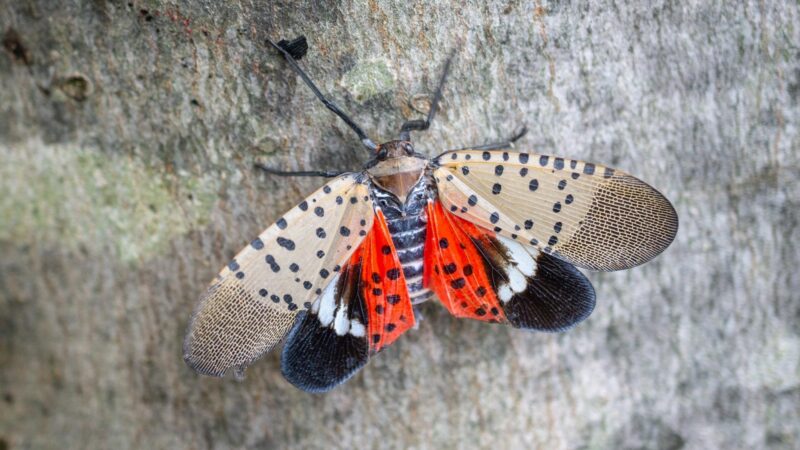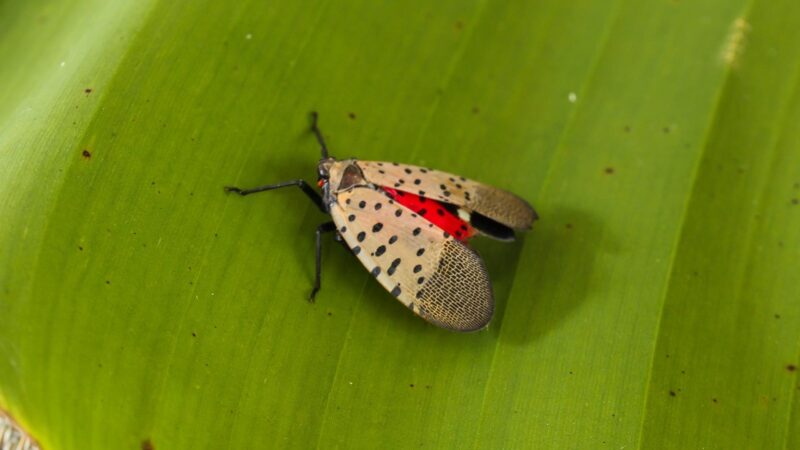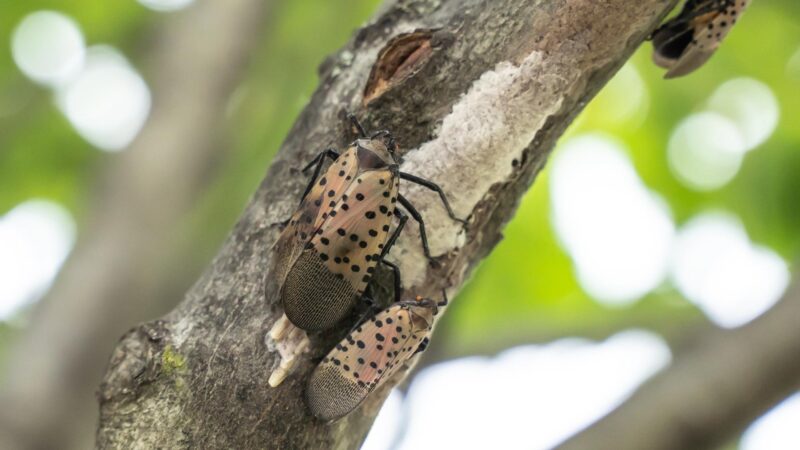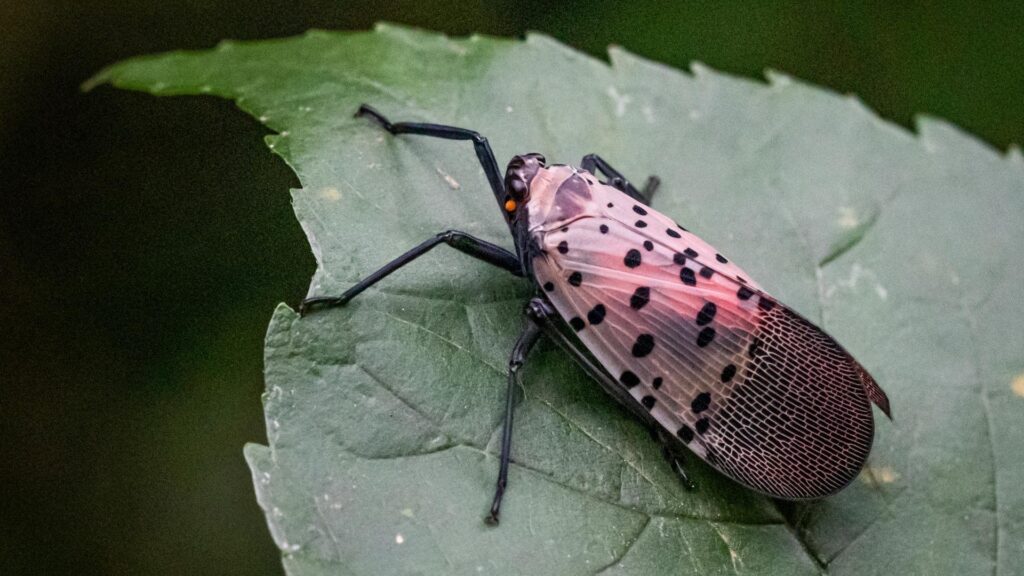The spotted lanternfly is an invasive pest originating from China. They have a big appetite for flowers and plants, including birch, maple trees, grapevines, and other trees.
How to get rid of spotted lanternflies? To eliminate the intrusive spotted lanternflies, mix vinegar with a rubbing alcohol solution and water in a mixing bowl. After mixing the three ingredients, transfer them to a clean spray bottle and shake it well. Once done, start spraying it to the affected areas.
By reading this guide further, you will know more about lanternflies, including their origin, characteristics, and various ways to get rid of them. So, let’s get this started!
Table of Contents
What Is a Spotted Lanternfly?

Spotted lanternflies are invasive pests that originated in China. These pests were first discovered in Pennsylvania in September 2014.
Adults are around 1 inch long and ½ of an inch wide at rest. Their forewing is colored gray with some black spots, and the tips of their wings are outlined in gray.
In addition, their hind wings have opposite patches of black and red with a white band. Their head and legs are black with a yellow abdomen and wide black bands.
These bugs love to feed a wide range of woody, ornamental, and fruit trees. Among the trees that are at risk of the attacks of these insects are:
- Apples
- Almonds
- Apricots
- Grapes
- Cherries
- Hops
- Nectarines
- Maple Trees
- Peaches
- Oak Trees
- Pine Trees
- Poplar Trees
- Plums
- Willow Trees
- Sycamore Trees
- Walnut Trees
These lanternflies cause severe damage to leaves, saps, vines, and crops. With that said, they can have a considerable impact on the agriculture industry, affecting the quality of life of the people experiencing their attacks.
Where Did the Spotted Lanternfly Originate From?
The spotted lanternfly or Lycorma delicatula originated in China and was first noticed in Pennsylvania in September 2014. These flies can be scattered long distances by people moving infested items or materials comprising their egg masses.
As a result, they can severely impact the country’s logging, orchard and grape industries.
Are Spotted Lanternflies Dangerous?

Spotted lanternflies are not dangerous since they’re not known to sting, bite or attack pets, livestock and people. These insects are not capable of biting since their mouthparts are designed only for sucking sap.
Are Spotted Lanternflies Dangerous to Humans?
The mouthparts of spotted lanternflies are only specialized in sucking sap. With that said, they’re not dangerous to humans since they are not capable of biting.
Are Spotted Lanternflies Poisonous to Dogs?
Currently, there are no known toxins discovered in spotted lanternflies, so these pests are not poisonous to dogs. These pests are also not known to bite or sting dogs or any other pets, so they are safe from the attacks of spotted lanternflies.
Why Kill a Spotted Lanternfly?
Spotted lanternflies infest various plants and trees to feed on the sap, negatively impacting overall plant health. This can lead to mold and attract many harmful bugs, leading to the untimely death of plants and trees.
What Kills Lanternflies in Contact?
Several items can kill lanternflies when coming in contact with them, such as:
White Vinegar
White vinegar is known for its acidity and intense acidic scent. This is why it’s not surprising that lanternflies sense the vinegar scent from afar.
To use, just put the white vinegar into a clean spray bottle and start spraying it on the lanternflies. The pure acidity of the vinegar will instantly kill lanternflies when in contact.
Commercial Pesticide
Another product that kills lanternflies when coming in contact is commercial pesticides. However, if you use this, the product’s label should state that it’s registered for a particular use.
For instance, if you are using a commercial pesticide for ornamental use, its label should say so. It’s the same for using the chemical for grapevine—the product label should state that it’s registered for grapevine use.
Most importantly, you must read the product’s label for the correct and safe usage of the item.
Essential Oils
One essential oil may come only as a deterrent for lanternflies, but a combination of several oils can kill these pests effectively. For instance, you can mix a few drops of lavender oil, tea tree oil, and peppermint oil into ten-ounce water and transfer the mixture into a clean spray bottle.
Once done, shake the mixture well and start spraying it directly to the lanternflies.
Dish Soap
When coming in contact with Dawn dish soap, lanternflies can drown, causing their early death. This is also much safer to use around pets, adults, and even kids.
The Dawn dish soap is particularly better to use due to its concentrated formula that can stick to the outer layer of the bugs, drowning them effectively. To use this, mix equal parts of water and dish soap in a clean spray bottle and spray it directly on the bugs.
The soapy solution will kill these pests, allowing you to have a bug-free environment.
Will Winter Kill Lanternflies?
Winter can kill many lanternflies, but mostly the grown-ups only. The eggs can endure the frigid weather, continuing the appalling cycle of their existence in the coming spring.
That’s why it’s crucial to eliminate egg masses so that you don’t have to deal with adults anymore.
How to Kill Lanternflies With Dawn Dish Soap?
You can kill lanternflies by using Dawn dish soap. Just mix the same amount of water and Dawn dish soap in a clean spray bottle and spray it directly to the lanternflies.
Will a Bug Zapper Kill Lanternflies?
Bug zappers are a convenient way of killing lanternflies both indoors and outdoors. This can be hung on your window sill, bedroom, patio, kitchen, etc.
The light of the bug zappers will lure spotted lanternflies into the zappers, electrocuting the pests, which kills them instantly.
Does Sevin Kill Lanternflies?
The Sevin Insect Killer is an effective killer of young and adult spotted lanternflies. This product can protect your home against spotted lanternflies for up to three months.
How to Get Rid of Spotted Lanternflies Naturally?
If you’re not a fan of using chemical means to eliminate these pests, here are some of the natural ways you can get rid of spotted lanternflies naturally:
1. Scraping off the eggs.
Scraping eggs from plant walls, plant stems, bark, cement, and other hard surfaces will naturally eliminate lanternflies. You can use a scraper to scrape the grayish, mud-like pileups (lanternfly eggs) so that you won’t have to deal with the adults.
2. Cut down the tree of heaven.
If you have a tree of heaven within your area, it’s best to consider cutting it off. This is because lanternflies are attracted to this tree, making their presence more apparent in your home.
3. Using a vacuum.
Another way to naturally get rid of spotted lanternflies is by using a vacuum. Just simply turn on your vacuum and discard the dead insects after the procedure.
4. Use vinegar spray.
Another way to get rid of spotted lanternflies is by using vinegar spray. Just pour some vinegar into a clean spray bottle and start spraying the solution directly on the pests.
5. Neem Oil Spray
If you’re considering natural ways to eliminate pests like spotted lanternflies, you can’t leave out the neem oil. This is an all-natural pesticide and fungicide solution derived from the neem tree seeds.
To make the solution, mix two teaspoons of liquid soap and four teaspoons of neem oil into a gallon of water. Once done, put enough of the solution into a spray bottle and spray directly to the spotted lanternflies.
What Do Spotted Lanternfly Eggs Look Like?
The eggs of spotted lanternflies look like an unequal spread of mortar smudged on any surface outdoors. These mortar-like smudges are the egg masses containing 30 to 50 eggs, covered with a mud-like mantle, giving them the gray coloring and cracked-mortar look.
How to Get Rid of Spotted Lanternfly Eggs?
If you have already identified the lanternfly eggs, you can eliminate these using the following steps:
- Get a putty knife and start scraping the egg masses on the surfaces.
- After that, put the scraped eggs into a container loaded with rubbing alcohol.
- Once done, seal, and discard the insects right after.
How to Get Rid of a Spotted Lanternfly Nymph?
According to Penn State, one can eliminate the spotted lanternfly nymph by using insecticidal soap, such as:
These products are ready-to-spray, so it’s very straightforward to apply. Before using, always read the product’s label to ensure correct product usage.
You can also try mixing rubbing alcohol with water and spraying the solution directly on the bugs.
What Pesticide Kills Lanternflies?
If natural means seem not to work out against lanternflies, use pesticides with carbaryl, imidacloprid, bifenthrin, and dinotefuran content. These active ingredients are known to control lanternflies effectively and are present in the following products:
Note: Always make it a habit to read the product’s label for appropriate usage.
What Trees Do Lanternflies Like?

Lanternflies are always clear about their preference. These insects like to consume the sap of specific trees, such as birch, black walnut, maple trees, willow, grapevines, and the tree of heaven.
How Do Spotted Lanternflies Damage Trees?
Spotted lanternflies cause significant damage to trees by consuming sap and releasing honeydew which stimulates fungi and mold development on trees.
What Do Lanternflies Eat?

Lanternflies eat the sap of several plant species, such as grapevines, birch, maple trees, black walnut, etc.
What Eats Lanternflies?
Among the top predators of lanternflies are praying mantises, chickens, yellow jackets, garden spiders, gray catbirds, etc.
Summary
Spotted lanternflies are very invasive. So, it’s best to deal with them right away when you notice their presence within your premises.
Consider using the given methods of this guide to eliminate your lanternflies issues and see how it makes a difference.